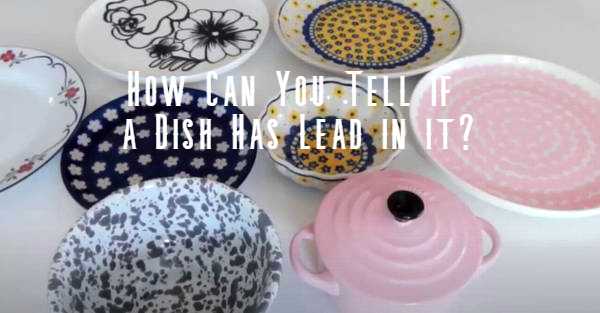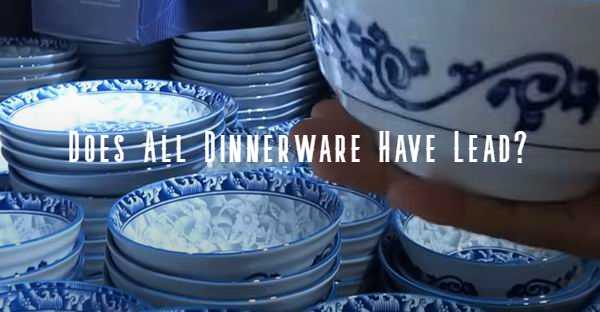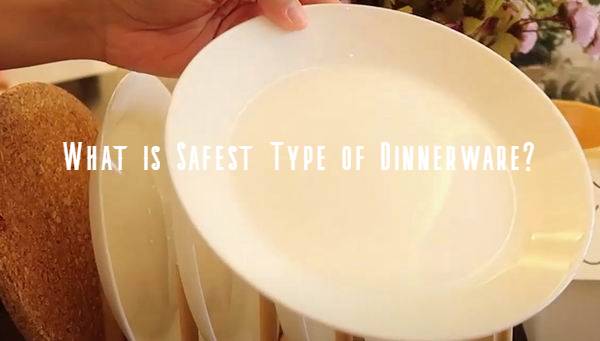
You might be very busy this fall. Coming home late at night, you could be too tired to pick and choose. Do you still use your old, vintage dinnerware? Bet, it’s beautiful and refined. Don’t forget about safety and health concerns. How to tell if dishes have lead? Any tableware you use, casual or luxury is to be non-toxic. Even slow ingestion of the poison is harmful. It has a cumulative effect, affecting virtually all systems and organs in your body. How to prevent the poisoning? You won’t determine it by sight. Quite naturally, chipped or cracked plates and cups are unsafe. It’s dumb as a coal shovel. Don’t use them anymore. Are there any other distinctive signs? Let’s learn how to distinguish them right now.
How Can You Tell if a Plates Has Lead in it?
Look around. The weather is commonly nice and comfortable. In Baltimore, daytime temperatures are pleasantly warm. Reaching 77-80 degrees, they benefit you with sunshine and comfortable warmth. Have you got your vacation right now? You can enjoy swimming or look at the blue sky.
Are you busy, doing a job? Working for10-12 hours every day, you would come home late at night. Long commutes could be exhausting too. Eating out would be a great idea. Do you stay home, avoiding it due to extreme weather events? It would do it also if you:
- feel tired;
- look pale;
- are irritable;
- lose your appetite;
- suffer from headaches.
The reason might be not evident. Your casual tableware is worth inspecting. What you should know about lead in China dishes? The toxic substance is extremely harmful. Swallowing or breathing lead results in lead poisoning. Is it really so dangerous? Accumulating inside your body, lead causes serious health issues. So, let’s study how to prevent it.

The Dangers of Lead Poisoning
Any day or night, you may absorb lead with water, makeup, food, or dust. Contaminated air is a result of mining and ore processing. Lead paint is extremely harmful. Besides, kids are especially vulnerable to poisoning. Thus, in 2013-2016, 0.9% of preschool children in the USA had elevated lead blood levels.
What about your casual dishes, bowls, and coffee mugs? Bet, their materials matter. Ceramic vs porcelain dishes are less dense and durable. Choosing them, you would consider their:
- shapes;
- designs;
- sizes;
- textures;
- applications.
Don’t forget to pay attention to the glaze and patterns. Thus, ceramics seems to be a safe, non-toxic option. It’s heat-resistant but fragile. Refined porcelain dishes and bowls don’t seem to do any harm to your health. The clay material itself is completely healthy. It’s inert and eco-friendly. The danger is in the glaze and decorations. Bright or irregular ones would ring alarm bells.
Does All Dinnerware Have Lead?
Bet, other risks and dangers exist. In September, you may go hiking or camping. Outdoor dining is enjoyable. You can arrange a picnic any weekend. What kind of stuff do you use there? Disposable plastic plates are not the healthiest solution.
Consisting of polystyrene or Styrofoam, they contain harmful neurotoxins. Leaching from the plate surfaces, they can cause cancer. Additionally, tons of plastic waste pollute the environment. The dishes you use at home are a whole nother. Porcelain dinnerware pros and cons are self-explanatory.
These refined and beautiful products suit everyday and occasional use. They are:
- elegant;
- versatile;
- durable;
- heat-resistant;
- beautiful and handy.
Their smooth, non-porous surfaces are easy to clean. Modern products are dishwasher-safe. They easily withstand exposure to heat, water and mild detergents. Most of these dishes are safe to microwave. But for the decorations or metal rims, it’s acceptable. Any glazed items may contain minor amounts of lead. Those that meet the rules are lead-safe.

What Brands of Dinnerware are Lead Free?
Your old, vintage dinner sets might be unique. Coming with beautiful floral decorations, they look beautiful. Refined plates and bowls cheer your heart with fond memories. Are you still using them? It’s safe if their surfaces don’t contact with citrus or fruit juices. Soft drinks, coffee and sauces may also leach lead out of the glaze.
Ordering laboratory testing is possible. Find a reliable lab nearby to clear up your doubts. Otherwise, use top-quality, branded, non-toxic products. Is Pyrex lead-free? Consisting of borosilicate or soda lime glass, it’s completely safe. Bet, you might use the iconic bakeware or cookware products in your kitchen.
Other famous brands include:
- Lenox;
- Tuxton;
- Fiesta;
- Malacasa.
Which ones are preferable? I would opt for a reputed and well-known American manufacturer. Thus, Pyrex is on the market for more than 100 years. Its glass pans and containers are versatile and easy to clean. So are ceramic dishes and roasters. They contain less than 0.1 ppm of lead that is acceptable.
How to Identify Lead in Dinnerware Products?
If you get vacations right now, you are lucky. Are you going to visit any foreign countries? Not only does the protection from dangerous viruses matters. Making a dive into a small craft or thrift shop, be careful. Garage and yard sales are also questionable.
Over yonder, you can buy any hazardous or poisonous products. Unlike large and reliable American factories, local craftsmen are independent. They may allow a breakdown in the technological process. Applying the decorations on the top of the glaze is sketchy. Additionally, artisans could fire their handicrafts improperly.
Small workshops don’t gain FDA certification. Knowing how to test for lead in ceramics, you are in full possession. It shouldn’t exceed the permissible exposure level. Don’t forget to look for a warning sign on the bottom. These items might be:
- decorative;
- not intended to serve food;
- harmful;
- containing lead in the glaze.
A yellow triangle should also warn you. So are the warning messages and labels. The absence of any label at all is a bad sign. It means, no authorities test the products, and you are to do it by yourself.

What Dishes Contain Lead?
Bet, lead-free dinnerware exists. It comes with the corresponding labels. The words “non-toxic” should make you chillay. The items come with plain white surfaces. Have you visited a restaurant recently? With a face mask, indoor dining is completely safe.
So is commercial dinnerware. It’s commonly top-quality, branded and lead-free. Modest, soft patterns are acceptable. They may contain trace amounts of lead. The reasonable limits should not exceed 0.5 ppm (parts per million). FDA requires it. Proposition 65 is much stricter. Its leachable limit of lead is 0.226 ppm.
Colorful glazes and decorations give you pause for reflection. Just try to avoid the products that are:
- worn-out;
- homemade;
- handcrafted;
- antique;
- highly decorated.
Modern products are in the clear. They meet high industrial and market requirements. Respectively, testing and certification are essential. Above all, traditional pottery should be under suspicion. Highly-decorated or terracotta dishes and pots might be toxic. Give them a second glance to prevent any potential hazards.
Do Vintage Dishes Have Lead?
Trace amounts of lead in your dishes and cups are acceptable. Even a transparent glaze may contain the substance. Lead makes the surface durable. Do you like your old, heirloom tea set? It might be beautiful and refined. Surviving multiple family celebrations, like birthday parties, it’s special for you.
If it’s still intact, it would speak for its top quality. What about discoloration? Corroded glaze or raised decorations on the surface may imply the availability of lead. It may poison your family members, especially the kids. The impacts depend on several factors, including:
- age of your beautiful cup and dish;
- color and composition of its glaze and decorations;
- frequency of use;
- the way you wash or clean it;
- your age and health condition.
Bet, the products manufactured before 1971 are especially harmful. Made and sold before the FDA regulations, they couldn’t pass its tests and certification. Would you like to retain your favorite dinnerware? If so, you should wash it by hand, avoiding heating and contact with acidic food.

How Do You Test Old Dishes for Lead?
Traditional terracotta pots and dishes are beautiful. They look rustic and attractive. But their transparent glaze may contain lead. Bright (orange or yellow) decorations could leach cadmium. Raised or rough surface would make you drop a bid.
What about your favorite heirloom cups and dishes? If they look too bright or shiny, will you throw them out of your house? DIY testing is possible. Do it, using:
- sanitizing swabs;
- special lead check pens;
- small kitchen knives;
- water or reactant solution.
Be careful while touching the surface. According to a study, absorption of lead through your skin is possible. DIY lead check kits let you verify your old-shoe pottery right at home. If the swab turns red, it’s harmful. Can you use these dishes and pots? Displaying them in your living room is appropriate. But don’t store food or eat your favorite dishes out of them.
Does Corelle Dinnerware Have Lead in It?
Do you like using colorful plates and bowls? A variety of patterns and styles are available. Consisting of tempered glass, these perfect products are top-quality. They are versatile and lightweight. Resistance to fading, scratching, and breaking makes branded cups and bowls practical.
Corelle porcelain is as strong and beautiful as the branded glassware. Nevertheless, try to choose the dinnerware set properly. Prefer the products that are:
- plain white;
- coming with minimalist designs;
- new and intact;
- meeting the national and local requirements.
Lead requirements and regulations continuously improve. Have you bought any dishes and coffee mugs after 2005? All of them are safe and non-toxic. Additionally, minimalist designs and simple patterns and beneficial. These items would become our favorite casual dinnerware. Functional and unfussy, they let you focus on your primary daily tasks.
Video Review: Do All Dishes Have Lead?
Bottom Line
Are you fixing to buy a new table or tea set? Nowadays, it’s not difficult. I would rely on a large, reputable store or marketplace. Top-quality, branded and properly labeled items are preferable. FDA testing and inspection guarantee their safety. Additionally, minimalist patterns are designs are perfect. They suit casual use well. What about your old vintage dishes? Check their surfaces, doing tests, and making sure they are lead-free. Enable healthy eating, even if you are very busy, and be well.
